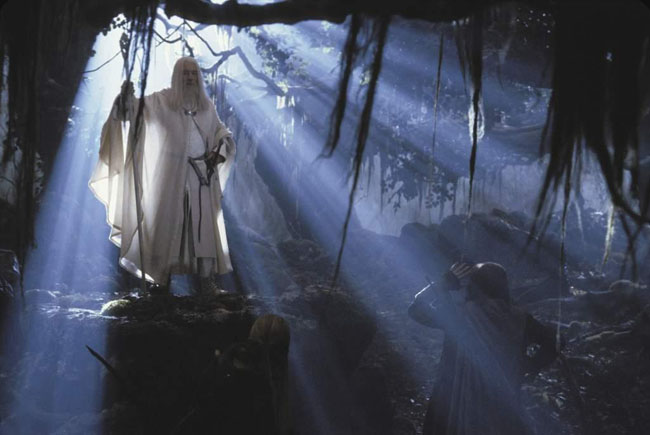CHICAGO – In anticipation of the scariest week of the year, HollywoodChicago.com launches its 2024 Movie Gifts series, which will suggest DVDs and collections for holiday giving.
Interview: Creative Director Richard Taylor of Weta, ‘Lord of the Rings’
CHICAGO – With the heralded release this week of Peter Jackson’s “The Lord of the Rings” trilogy on Blu-ray DVD, the opportunity to appreciate the epic scope of the visionary Middle Earth in the home theater has never been so highly rendered.
Richard Taylor is Creative Director for the Weta Companies of Wellington, New Zealand, whose operations and workshop provided the design, fabrication and on-set operation of the creatures, special make-up effects and prosthetics, miniatures, armor and weaponry that makes up the three popular films in the LOTR series.
 Photo Credit: © New Line Cinema |
HollywoodChicago got the rare opportunity to interview Mr. Taylor in anticipation of the Blu-ray release. He spoke generously of the synergy necessary to create the whole of the Middle Earth out of electronic bytes and special effects clay.
HollywoodChicago.com: When approaching the Lord of the Rings and creating a look from the source novels, what initial collaborative agreement or rules about the specifics of that look were established between you and Mr. Jackson?
Richard Taylor: That cuts to the heart of the approach for something like this. You have to set ground rules otherwise the world starts to break and loses its plausibility. Specifically, Peter wanted what I call ‘the chessboard of Middle Earth’ to have a complete believability on a flora and fauna level, so that the audience would be more accepting of the fantasy elements that are going to be set up for this world. Even the fancy elements and characters had to have an anatomical reality, so the audience could relate back to our own known world. There are no dragons with small wings that come at you in reality, so there we had to establish a firm way to move forward. Once that was established the first three or four weeks of the entire process, we all understood it and never veered from it.
HC: Creating the type of miniatures, armature and special effects necessary for something as complex as the Lord of the Ring trilogy is a specific marriage between creativity and current technology. At what phase in preproduction does that marriage have the most difficulties?
RT: Again, that question cuts to the heart of the challenge of making these films, because what is interesting on most projects and relevant to Lord of the Rings is that Peter had such an intuitive understanding and vision for what the technology of the future would be, that he quite happily left holes in the movie that would one day be filled with digital creations. Sometimes the technology didn’t even exist in pre-production to do the very things he wanted to do later in the film. That confidence came from his innate understanding of the technological journey, the computational power and the increasing nature of it all.
![The Way They Were: Poster Art from ‘The Lord of the Rings: The Fellowship of the Rings’ [2001]](http://www.hollywoodchicago.com/sites/default/files/LOTR.jpg) Photo Credit: © New Line Cinema |
HC: Considering the now amazing legacy of both the literature and films of Lord of the Rings, what do you look back upon with the most pride in the way you pulled it off?
RT: This is a little less tangible that just one thing. The first is that we were able to empower this young group of New Zealanders to achieve at a level that would fulfill an audience’s expectations. Only one-eighth of our staff had ever worked on a film or TV show before. The group came together driven not by their experience or knowledge, but more by their artistic passion and their inspiration. That makes for a challenging outfit, but ultimately makes for a far more enjoyable journey, because people are unbridled by the knowledge attained, and they go in with a complete conviction that anything they throw themselves at will ultimately come out okay.
If I relate to one single character it would be Lurtz, played by Lawrence Makoare, because he sits in Middle Earth in a completely plausible way, he communicates all the evil intent that is buried within him and for me he feels a part of Tolkien lore. I’m very proud of that character.
 Photo credit: © New Line Cinema |
HC: Considering the technology you had when you made the first film, is there anything you would change in your approach in creating the Lord of the Rings or maybe something that would be easier to do, if you had the technology of today?
RT: ‘Easier’ is an interesting word, because of the nature of filmmaking and filmmakers, especially effects artists like ourselves. I don’t think you ever make it easier on yourself [laughs] because you are always pushing the bounds of technology. Whenever we tackle a new film, we never want to fall back on the techniques of what we accomplished in a previous film, in the sense that you don’t want to be disingenuous to a new client when forging a new world. Specifically in a film like ‘Avatar’ or ‘District 9,’ the desire is to break new ground.
But if I reflect on what we were able to accomplish on Lord of the Rings and whether we would have done it differently, there is no doubt with technology today, the unbelievable computation power and the physics based analysis on a digital level that is available, certain things would have been done differently, arguably more simply. The challenges of linking exterior locations, miniature elements and digital characters is very tricky and today there is more of a freedom with modern digital technology that just wasn’t available 10 years ago.
HC: You’ve had Oscar wins in three different years. What amazes you about the show and spectacle of the Oscars?
RT: We acknowledge the Academy from overseas for giving us one of the great treats of a lifetime. And in the case of my wife and I, three times, and we were fortunate enough to win five Oscars. Way above the actual acknowledgment and the reward of the trophy is what the Oscar represents, coming from New Zealand. When we grew up, watching the Academy Awards on black and white television, and then to be invited to be a part of it from the other side of the world, that is an acknowledgment to the generosity of the American film industry.
The Academy was founded in America, it is a very American institution, but it shares the celebration of film at an international level.
Click here for the HollywoodChicago.com DVD review.
Click here for the Weta website.
 | By PATRICK McDONALD |


